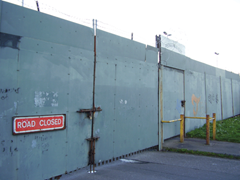 Peter Cheney reviews the Justice Minister’s plans for community safety, including fewer walls on the interfaces.
Peter Cheney reviews the Justice Minister’s plans for community safety, including fewer walls on the interfaces.
Interface communities who want to remove barriers will get help from government, under the Department of Justice’s draft community safety strategy. Forty-seven barriers were ‘inherited’ from the NIO and the term peace walls “appears increasingly outdated”.
The emphasis on sharing is the most innovative part of the document. All public services also have a responsibility to provide “shared spaces” where people can congregate without the threat of aggressive flags and emblems.
Consultation on the strategy, for 2011 to 2015, will close on 15 April. It follows on from the previous 2003-2008 strategy; a replacement was delayed until justice was devolved.
“Community safety” is frequently used in official language. In practice, it means finding local solutions to local problems with the help of organisations other than the police e.g. councils, youth clubs or the Housing Executive. Its overall aim is to reduce crime, the fear of crime, and anti-social behaviour (i.e. aggressive, intimidating or destructive activity that affects someone’s quality of life).
In summary, the department wants communities to be not just safer, but shared and more confident.
Under the first theme, anti-social behaviour “can mean different things to different people.” Neighbourhood watches, CCTV and warning letters help to tackle the problem. Anti-social behaviour orders (ASBOs) are usually a last resort, and readers are asked whether they find these to be effective. The department is prepared to consider alternatives.
‘Early years’ and ‘early stage’ interventions are considered important e.g. home visits to troubled families, referrals to drug rehabilitation, youth conferencing. Much of this work is done outside the justice system but can reduce offending later on in life.
In 2009-2010, the PSNI recorded 2,148 hate crimes, mostly sectarian and racist. The “devastating impact” on victims is greater than the numbers suggest and new proposals are due to be published.
Reported crime levels have steadied at around 110,000 offences per year since 2007 but estimates suggest that less than half of all crimes are reported. Hate crime, domestic violence and sexual abuse are particularly hidden. Surveys suggest that two-thirds of people think that crime is now worse now than two years ago.
To tackle fear of crime, communities must have an “accurate understanding of the risk and likelihood of crime”. That suggestion seems to warn against sensational media reporting but the department also admits that the system can improve how it communicates with the public.
“Partnership” is used extensively. This is a common phrase in government documents but has become more relevant since devolution. Justice, social work and education policy are now run by the same government rather than being split with the NIO, which often appeared distant.
Practical examples will include the proposed policing and community safety partnerships and continued support for voluntary groups such as NIACRO. The strategy’s budget is not yet agreed.
Introducing the paper, David Ford described Northern Ireland as a “comparatively safe place to live” but its communities “do not always feel safe”. A long-term approach, dealing with the risk factors that can lead to offending, was also needed. He added: “I firmly believe that shared communities are safer communities.”





